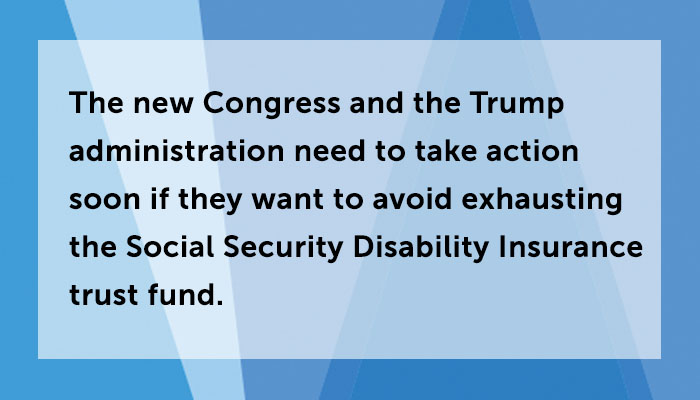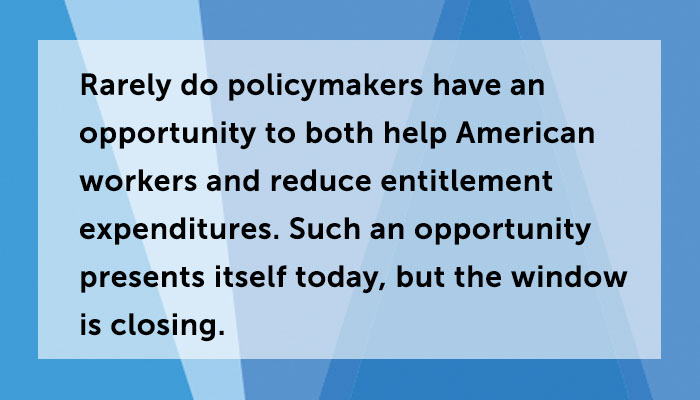This post was first published on Insurance Thought Leadership.
 The new Congress and the Trump administration need to take action soon if they want to address the projected 2023 exhaustion of the Social Security Disability Insurance (SSDI) trust fund and protect hard-working Americans. Every year, millions of Americans lose their jobs due to injuries or illnesses, but policymakers can take concrete steps to maintain these workers’ incomes and reduce spending for their SSDI, Medicare, and other public benefits.
The new Congress and the Trump administration need to take action soon if they want to address the projected 2023 exhaustion of the Social Security Disability Insurance (SSDI) trust fund and protect hard-working Americans. Every year, millions of Americans lose their jobs due to injuries or illnesses, but policymakers can take concrete steps to maintain these workers’ incomes and reduce spending for their SSDI, Medicare, and other public benefits.
The first and most critical step is to empower states and the private sector to test promising approaches for helping ill or injured workers stay in the labor force. Otherwise, policymakers will be faced with either cutting disability benefits for workers who need them or diverting revenue from the trust fund that is intended to pay for the same workers’ retirement benefits. Policymakers chose the latter course in 2015, when the SSDI trust fund was projected to dry up within a year. But that option will be even less attractive in 2023 because the retirement trust fund is on a trajectory for exhaustion in 2035.
The Nature of the Opportunity
Research shows that a large but unknown portion of the more than two million workers who leave their jobs each year for medical reasons could continue to work if they received timely, evidence-based support. Yet many workers with work-threatening conditions fall through the cracks in a fragmented support system and enter SSDI instead.
The private sector already has the tools to help more of these workers stay in the labor force, but the tools aren’t targeted to those most likely to enter SSDI—those in relatively low-skill jobs with limited education. Many employers of skilled workers provide job retention services along with short-term disability and health insurance. Workers’ compensation is available to most workers if their injury or illness is due to work, but the degree to which they receive job-retention services varies. Some states’ vocational rehabilitation agencies also provide job retention services, but their size and scope is very limited.
The fact that some job retention services are already available reflects the substantial benefits of these services to workers, employers, and state governments. It is clear, however, that the provision of services is suboptimal because of misaligned financial incentives and institutional constraints. Most notably, financial incentives created by federal programs work against job retention rather than for it: federal support for ill or injured workers is almost entirely reserved for those who leave the labor force and enter SSDI. After another 24 months, SSDI entrants also enter Medicare, and many with sufficiently low incomes receive Supplemental Security Income, Medicaid, and various in-kind benefits. Furthermore, there is a sharp drop in the federal taxes collected from workers who stop working and enter SSDI.
Keeping these workers on the job and out of SSDI could save the federal government billions. The potential gains of investing in job retention far exceed the costs—which is why policymakers now have the chance to help hard-working Americans as well as reduce the size of the federal deficit.
The Need for Immediate Action
 To build on what we’ve learned thus far, federal policymakers must provide states and the private sector with opportunities to test various ways to help Americans whose livelihoods are threatened by medical conditions. Implementing a new policy based on our current limited knowledge could harm, rather than help, many workers, or it could result in new costs to federal and state governments that exceed the savings to public programs. For instance, policies that excessively push workers to pursue work when they are in dire need of SSDI and Medicare would harm their well-being. Likewise, policies that spend significant resources on services and supports that do not at least pay for themselves through reductions in program expenditures will increase government spending.
To build on what we’ve learned thus far, federal policymakers must provide states and the private sector with opportunities to test various ways to help Americans whose livelihoods are threatened by medical conditions. Implementing a new policy based on our current limited knowledge could harm, rather than help, many workers, or it could result in new costs to federal and state governments that exceed the savings to public programs. For instance, policies that excessively push workers to pursue work when they are in dire need of SSDI and Medicare would harm their well-being. Likewise, policies that spend significant resources on services and supports that do not at least pay for themselves through reductions in program expenditures will increase government spending.
Instead, policymakers should plan to scale up, replicate, and improve test systems that work and stop supporting those that do not. Over the past few years, we and others have identified many opportunities to test such systems. For example, the three states with public short-term disability insurance programs—California, New Jersey, and Rhode Island—could pilot-test proactive case coordination and behavioral interventions to help their claimants stay at work. Other states could test similar approaches for their own employees, and accountable care organizations could test the use of job retention as a quality metric. On February 23, Mathematica Policy Research’s Center for Studying Disability Policy is hosting a live webinar, “The Promise of State Initiatives to Prevent Long-Term Disability,” to discuss these and other state-level initiatives that can help workers keep their economic independence and save billions of taxpayer dollars.
Such tests are not likely to occur, however, unless federal policymakers lead the way. They could do that by (1) making the testing of promising systems a national priority, (2) establishing an interagency office to lead the effort, (3) providing modest funding to gain the participation of states and the private sector, and (4) supporting learning via rigorous evaluation.
Rarely do policymakers have an opportunity to both help American workers and reduce entitlement expenditures. Such an opportunity presents itself today, but the window is closing on our chance to address these issues and preserve the SSDI trust fund.



